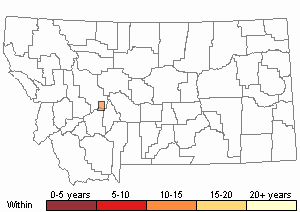View in other NatureServe Network Field Guides
NatureServe
Montana
Utah
Wyoming
Idaho
Wisconsin
British Columbia
South Carolina
Yukon
California
New York
Scarred Dart Moth - Euxoa cicatricosa
General Description
The Scarred Dart (Euxoa cicatricose) is a medium-size (29-32 mm wingspan) streaky grey and yellow-brown moth. The head and thorax are yellow-brown and grey. The prothoracic collar is edged with pale scales and the tegulae is trimmed with scattered black scales. The forewings are yellow-brown or grey brown with lighter streaks, in particular the subterminal area. The costa, the spots, and the area distal to the claviform are pale yellow or orange-brown. The orbicular spot is round. Veins CU1 and M3 are pale-edged and projecting to the wing margin. There is a small black basal dash that is reduced to a few black scales in many specimens. The fringe is dark. The hindwings are white, with sooty brown scaling on the veins and forming a wide diffuse terminal band. The fringe is white. The male antennae is moderately bifasciculate (Anweiler 2003).
Phenology
The early stages are unknown. There is a single annual brood, with adults on the wing in late summer. In the province of Alberta adults have been collected in late August and the first half of September (Anweiler 2003).
Diagnostic Characteristics
The Scarred Dart is closely related to and very similar to the Rubbed Dart (E. detersa), which is darker, in particular the hindwings, and is much less streaky in appearance. The male genitalia of the Scarred Dart is nearly identical to that of the Rubbed Dart, but Scarred Dart females differ in having a single row of stout setae along the edge of the ovipositor lobe in cicatricose (scattered in Rubbed Dart). E. niveilinea is also similar, but is darker and less streaky, has a white transverse line on the thorax, and males have much longer saccular extensions on the valve (Anweiler 2003).
Range Comments
The Scarred Dart is found in the intermontane region and western Great Plains from southern Canada to southern California, Arizona, New Mexico and west Texas, east to western Nebraska and North Dakota (Anweiler 2003).
Observations in Montana Natural Heritage Program Database
Number of Observations: 4
(Click on the following maps and charts to see full sized version)
Map Help and Descriptions
Relative Density

Recency



 (Observations spanning multiple months or years are excluded from time charts)
(Observations spanning multiple months or years are excluded from time charts)
Habitat
The Scarred Dart is generally found in arid areas with sparse vegetation and loose granular soils (Anweiler 2003).
Stewardship Responsibility
References
- Web Search Engines for Articles on "Scarred Dart Moth"
- Additional Sources of Information Related to "Insects"





